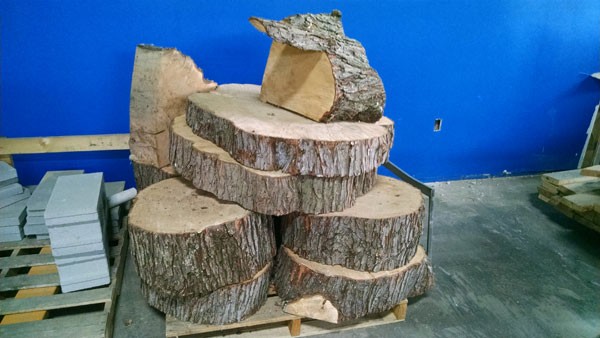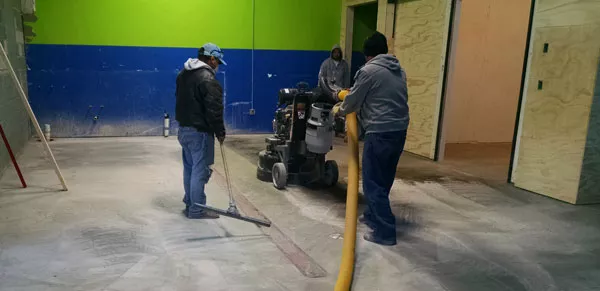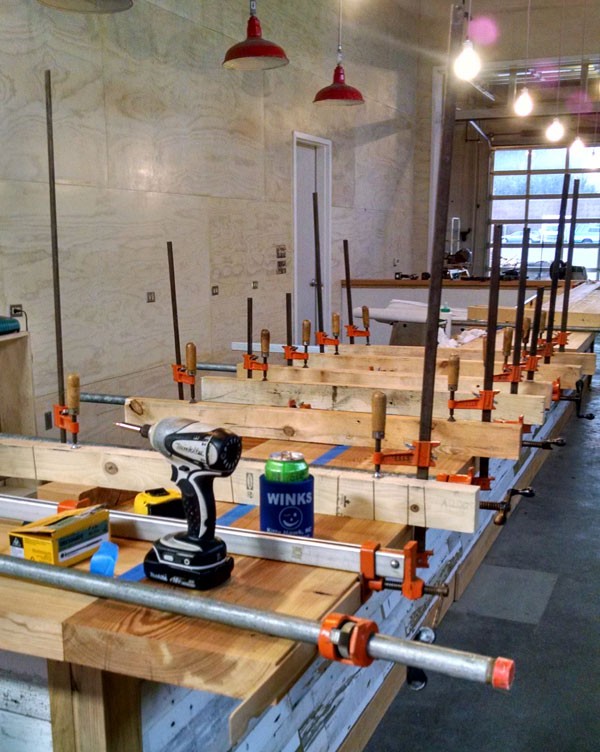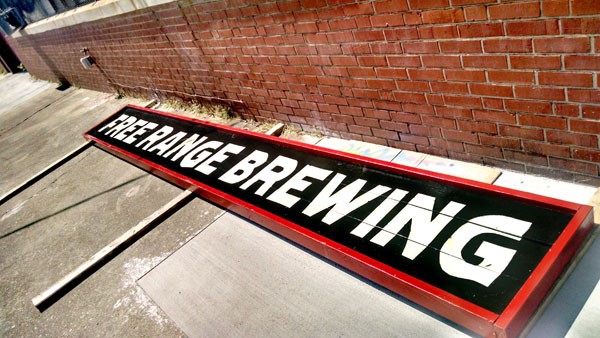OCT. 28, 2014 – Jason Alexander is already on site at the future home of Free Range Brewing, meeting with an agent who helped find the space. I wander around to take pictures of the not-that-much-here-yet. A new concrete pad has been poured for the brewhouse area, with a drainage trench slicing through it. The cold room has been erected nearby, and rudimentary framing has begun.
Meeting's over, and I get a brief walk-through and answers to my questions. They'll be capable of brewing 3.5 barrels (110 gallons), to be housed in 7-barrel fermenters. For now, the equipment sits under plastic tarps in the back. The brewhouse's former home is the New English Brewing outfit in San Diego, outgrown when they upgraded their system size to 15 barrels.
Out back are stacks of wood, remnants of the former Mecklenburg Mill just up North Davidson Street. A traveling lumber mill will set up on-site to transform these relics into the future bar-top.
So you're interested in opening your own brewery. Maybe you've seen the number of other brewers skyrocket in recent years, and you wish to join their illustrious ranks. Perhaps you've homebrewed a few times to positive reception, and you aim to translate that hobby into your vocation. Possibly, you drank several delicious beers crafted by others, and you're of the assumption that anyone can brew like that.
If your hopes and dreams resemble any of these, and opening a brewery appeals to your sensibilities, then allow me to echo another's words real quick and I'll credit them at the end: "Don't do it."
Running a brewery isn't just waving a magic wand at grain and water and hops until beer appears; it's dealing with dangerous gases, caustic chemicals, scalding water and a dozens of other things that can harm or even kill you. Just getting that brewery open is hell. It's not flipping a switch and you're in business; it's assembling a complicated, resource-hungry manufacturing system at the same time you're building a neighborhood bar. Prepare to deal with bureaucracy at three different levels, and a mountain of ensuing paperwork to follow. This even assumes you can raise a pile of money in the first place; figures range from a meager $50,000 initial investment for a nanobrewery operation up to over $1 million for a larger-scale production brewery.
Let's start with the first step in the nightmare of opening a brewery: simply finding a location. For starters, the city of Charlotte requires your taproom to be no fewer than 100 feet from a residence. Better get used to narrowing your search even further, as breweries are limited to locations zoned I-1, I-2, B-1 or B-2.
Once you finally locate a space you have your heart set on, prepare to be out-bid. Russell Fergusson, a Charlotte-area small business lawyer, has helped several Charlotte-area breweries through their opening and expansions. "The most recent impediment is the rapid pace of real estate development has returned. And so areas that might have the zoning and the structural ability to have a brewery may be an old industrial space that's also appealing to an apartment developer who has eyes to turn it into a four- or five-story building."
Brothers Jason Alexander and Jeff Alexander are clients of Fergusson's, and the proprietors of soon-to-open Free Range Brewing, set to occupy 2320 N. Davidson St., nearly right across the street from the existing NoDa Brewing. "We looked for property for over two years, a year heavily, to where we were really losing it," Jason confesses. "It's still a really challenging market because a lot of the spaces that fit us, because we're not a production brewery, were restaurant spaces. Those spaces were not in our budget. If they were, there were a dozen other restaurants trying to expand into that space."
NOV. 14, 2014 – The framing for the bar area at Free Range is up at last. The future bathrooms are delineated as well. A wooden skin now covers the formerly naked studs behind the bar as the walls take shape. Veins of electrical conduit snake their way through the opposing unfinished wall. In the back of house, the brewhouse no longer hides under its plastic covering, and two serving tanks rest on pallets nearby.
A new pile of material has arrived: reclaimed wooden siding from a turn-of-the-century NoDa mill home, destined to provide a face to the future bar. White paint flakes off the planks — reminders of the many seasons they've seen in the neighborhood.

- Jonathan Wells
The waiting game sucks. "One of the biggest hurdles for the brewing business start-up is the timing it takes," Fergusson says. "Before you can apply for your TTB licensure — so you're going to need federal and state licensure, you're going to deal with local zoning laws — you cannot start the TTB licensure process, which takes 90-something days now, until you have a lease." The Alcohol and Tobacco Tax and Trade Bureau, commonly known as the TTB, will also need to approve beer names and label designs going forward, so get used to them.
It's important to remember that brewing beer is manufacturing a controlled substance, and you must be approved to do so before that first drop can be made. Chris Goulet, El Presidente (according to his email signature) at the Birdsong Brewing Company, continues the licensing narrative: "Once you've got that TTB approval, [ABC will] approve your commercial permits relatively quickly. The trickiest one is actually the retail permit, your taproom, you need some additional documentation for. For new breweries, it's always a surprise."
Federal and state alcohol licensing isn't the only approval you'll be seeking; prepare to get to know the city and county planning departments better than you hoped to, and their resources are stretched thin.
Goulet recently guided the Birdsong outfit into a larger facility, and it wasn't easy. "Last year, we were about seven weeks between submitting plans and actually getting our permit." Their original facility, which opened just a few years ago, only took three weeks to get plan-approved.
Fergusson explains that nowadays, "you've got a backlog of [applications] in permitting; the state isn't hiring tons of people to deal with this."
So what level of government is the hardest for prospective breweries to deal with? "It's hard to grade bureaucracy," Fergusson says with a chuckle. "In the past, it was the city. Each of them has unique frustrations. The Feds are very thorough and detail-oriented, but you can access their resources on the website, ascertain what you need to do, and then you just have to do it, but you need to wait the very longest with them. The state, I find to be very reasonable — I hope they read that — but they have some laws that have not been revised in a very long time with some gaps, and a lack of capacity to deal with the uptick in alcohol production. The city has a combination of all three, with an arbitrary element thrown in — they haven't dealt with these things before, and over the last four years the states of bars and restaurants and patios have been in flux."
NOV. 20, 2014 – It's unbelievably loud in here; the concrete floor is being ground down. In the brewhouse area, the floor will slope gently to the drainage system, requiring multiple passes from a mean-sounding machine. The rest of the space will simply receive a face-lift, but the concrete's anvil coating slows progress. At least we know it's durable; the building held up to use as a machine shop since being built in 1950.
Eventually the floor will be given a clear-coat while the brewing area will be thoroughly sealed. Once the grime has been removed, the floor shimmers in the overhead lights. It's hard to hear myself think over the din, and my visit is brief.

- Jonathan Wells
In many ways, opening up a brewery carries the same woes any prospective business would: approval and inspections. Per Goulet, "You've got a plan reviewer that says, that's the right number of toilets, check. And then you have an inspector who comes out and says, this isn't the right number of toilets. It's non-stop. I don't know why they hate small businesses as much as they do, but that's how it works."
How painful could the process possibly be?
"I'd have to ask my G.C.," Goulet says, "but there are probably 200 relatively small changes we made to the plans to correspond to the inspectors."
And don't get him started on trees. Even after selecting trees from a city-approved list of species and planting them on-site, the inspector had a difference of opinion and insisted they be replaced. "I'm going to spend $7,000 on [different] trees. I could actually probably hire a couple more bartenders instead, and feed revenue back to the city, but instead I'm going to spend it on these ornamental plants."
Yet, opening a brewery isn't as straightforward as other prospective businesses due to its exotic nature. Fergusson spells it out: "Opening a brewery is different because it is two things — it's a manufacturing facility, and it's a bar. Manufacturing commonly has a distribution aspect to it and a production aspect to it, but there's not a lot of manufacturing that's as sexy as making beer, where you have a lot of people that want to come and consume it right at the source."
Make no mistake; this isn't homebrewing in your garage with a propane burner and an igloo cooler. Brewing beer on a production-level scale has immense resource needs. Goulet loves to talk about his newest toy: a 2 million BTU boiler, with over 100 times the heat output of my gas grill at home. The boiler is to provide steam heat for the brewhouse equipment, and will be tasked with bringing almost 1,000 gallons of liquid in the kettle to a boil, much more than the average brewer's five-gallon batch size. "It has a three-inch gas line running to it. Part of the reason we picked that facility is because it had a big gas line to start with. We were like, 'Oh, well that'll save us some time.' We lucked out on that one."
Free Range wasn't as fortunate. "Electricity was a big one," Jason Alexander laments. "It was a budget-breaking surprise. To find out that a building that your landlord said, 'Oh yeah, there's tons of power here, just look at it.' Our naiveté in that manner led us to say 'Looks good' rather than pay somebody to let us know for sure what it had ... That set us back a decent bit." Before the dust settled, the space got "all new everything — gas, water, electrical, mechanical — it's all new."
That's not to say Birdsong's new building was immediately suitable for their needs, though. "We put in a larger water line," Goulet says, "ran 800 amps worth of power, so there's a lot of stuff that has to bulk up because it's a factory! Your product is delicious beer, but it's still a factory."
FEB. 4, 2015 – Yesteryear's beams from the Mecklenburg Mill have been planed down, and are ready to become today's bar-top. They're still cumbersome: at two inches thick and up to 12 feet long, they can each clock in around 150 pounds. Installation is slow-going, and a forest of clamps arises to ensure proper seating of each individual piece. I set down my Sierra Nevada to joyfully lend a hand to the installation process. Why miss out on the opportunity to be part of a story, versus just observing it?
Beneath our workspace, the bar's face has already gone up. It's been pressure-washed thoroughly but much of the original paint remains, lending a certain rustic air to the room. Nearby, former school bus seats clad in brown leatherette unceremoniously lean on the floor. It'll take some work to get them in place, but they're destined to be a row of seating options.
Behind me, the brewhouse is in place. The stainless steel tanks have been carefully polished, and sit proudly upon the red skid-preventative floor. A tankless hot water heater hangs in the corner; it's the first time such a system makes an appearance in a Charlotte-area brewhouse. We're still not brew-ready just yet; glycol lines have yet to be run to each fermenter, nor has the auger from the mill been connected to the mash tun. Jason simply says, "Soon." I respectfully don't ask for a timeframe.

- Jonathan Wells
-
A stop at Free Range found the owners hard at work.
Finally, after the ink dries on all necessary permits, the plans receive approval, the infrastructure upfits are installed, the brewhouse equipment is placed and piped, and the entire seemingly unending project receives ultimate approval. It's time to brew your first batch of beer. Odds are, you've never brewed on a system this size before, and your old recipes need to be scaled up. Easier said than done; you also have to factor in what's called "brewhouse efficiency." That's right, all brewing systems are not created equal, and you'll have to further tweak the recipe to ensure arrival at the desired end result. The heat source going to your boil kettle is also a concern, as it was for Goulet and Birdsong. "We have a direct-fire system here, so moving to a steam-fired system is a big switch. We've had to adapt recipes, we knew we were going to have to do that, but that required some testing and experimentation."
Keep in mind, no matter how well you planned for every step of the process, you're not going to finish this project on time. As Jason can attest, "everything takes longer; nobody's joking when they say that. Everything takes longer than what you planned, everything takes a lot more money than what you planned, nobody gets around that, there's no way to do it."
I have yet to see a single Charlotte brewery launch precisely when they intended, and I doubt I ever will. There certainly are ways to minimize your exposure; Russell Fergusson stresses that prospective brewers "do your research before start spending money. That means know how long it's going to take, know who's going to be available to help you with professional services, and price it out. Don't get halfway; halfway is nowhere."
It's not all fun and games yet, even if you've mastered your new brewing equipment. Sure, you're going into business for yourself, but you now have a new boss: yeast. Without proper care, your fermentations may not properly complete. Worse yet, you run the risk of infection issues that can result from improper procedures. Yeast doesn't care if it's the weekend or if you haven't had a day off in months; its job is to convert sugars into alcohol and carbon dioxide, and it requires your attention.
I asked Goulet if he wished to impart any advice to up-and-coming brewers-to-be. His simple advice was, "Don't do it." He proceeded to paint a very vivid tale of Sunday mornings in the brewery, even though seven other folks toil in that atmosphere. He mourns the lack of days off, and scoffed at the sheer breadth of useless knowledge he's accumulated. But when I confront him with words in the same vein as his ("don't do it, think twice, stay away"), a smile grows on his face.
"And that's what people told me before I started, and I ignored them. [New brewers] won't listen to me, that's fine. I didn't expect them to."
The Free Range project is behind schedule; back in October, they were optimistic about beginning to brew in December. Now it's April, and a parade of unforeseen interruptions has postponed that important first brew day until this very week. But Jason Alexander is undeterred. "It's not a nightmare," he offers, "it's your hardest dream."

- Jonathan Wells
-
A sign of good things to come?
